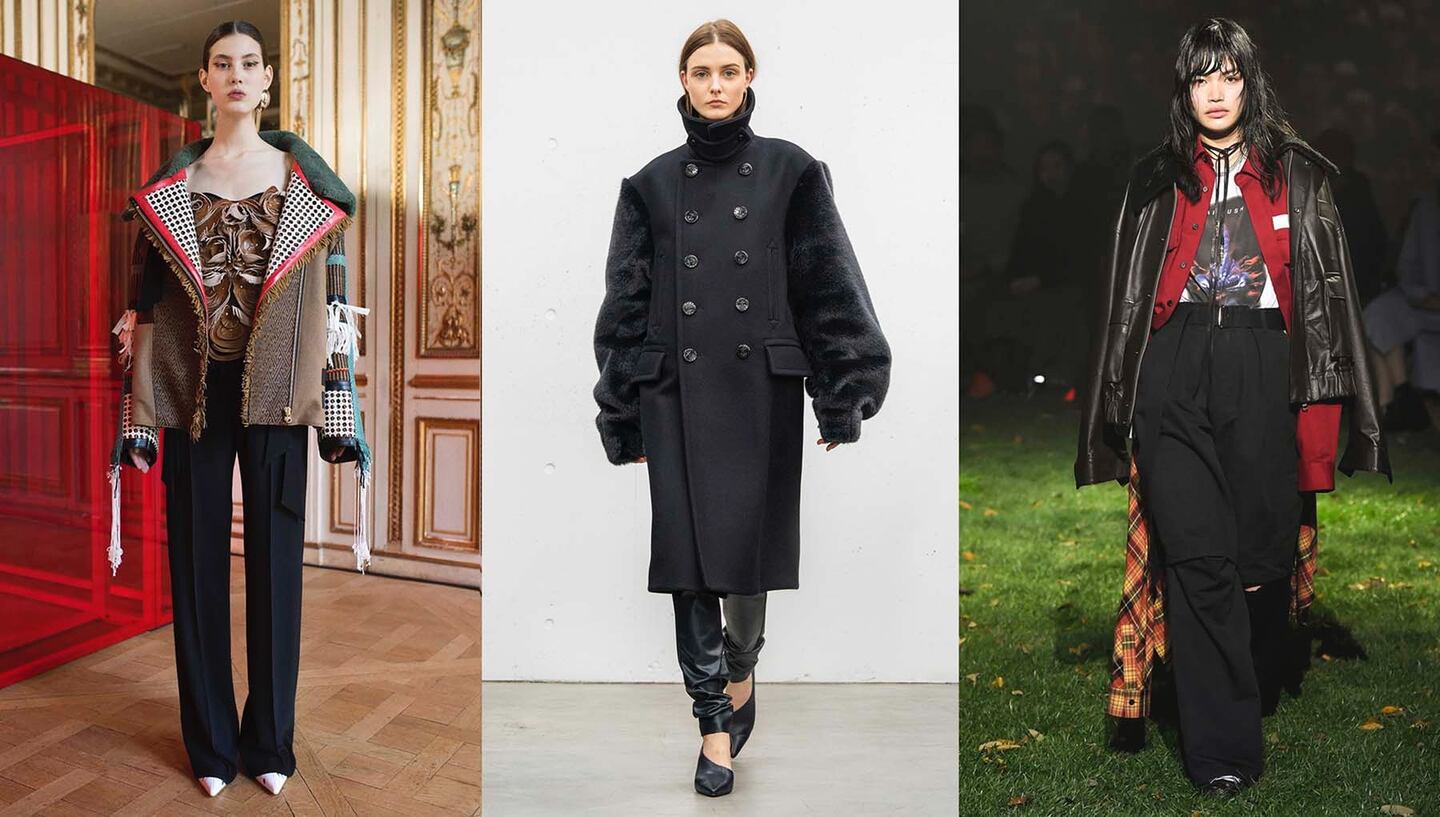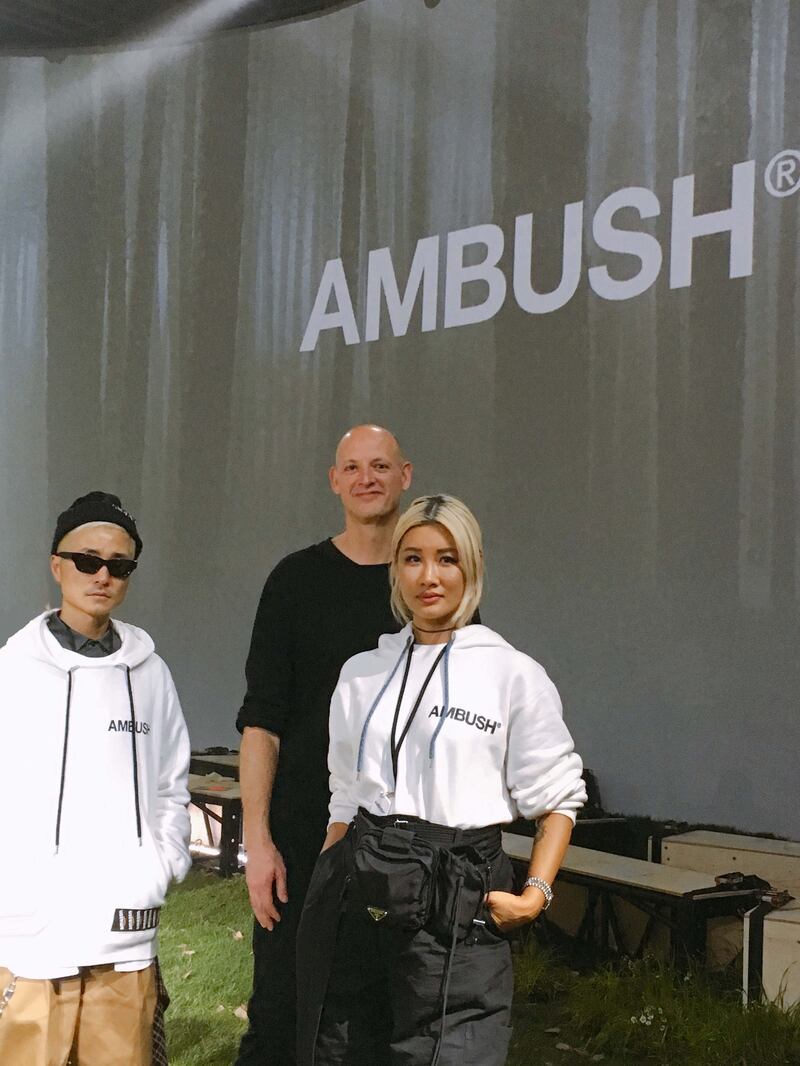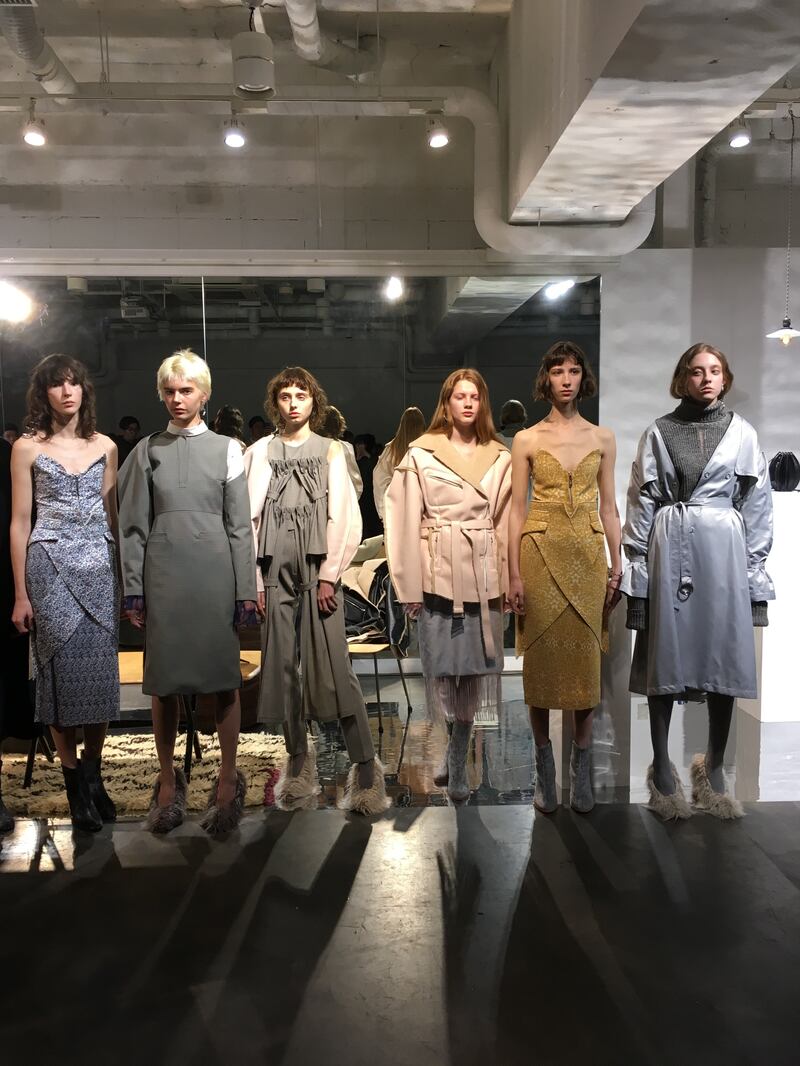
The Business of Fashion
Agenda-setting intelligence, analysis and advice for the global fashion community.

Agenda-setting intelligence, analysis and advice for the global fashion community.

TOKYO, Japan — It's not all about Harajuku. From the bohemian Shimokitazawa district to the more traditional Asakusa area, the wild and eclectic creativity of Japanese consumers has wielded enormous influence on fashion here and beyond, spawning a plethora of websites and social media accounts with street style snapshots of Tokyoites dressed in everything from punk otaku to dolly kei style.
With the city sidewalks as their runway, fashionable Japanese youths flaunted their sky-high platforms with carefully layered looks, sporting cult labels like White Mountaineering, Neighborhood, Nanamica and Mastermind, as they attended a newly energised Tokyo Fashion Week for the Autumn/Winter 2018 season, which began alongside an early hanami season on Monday 19th.
Fashion week becomes a magnet for the most dedicated street style heroes. But increasingly, many of these peacocks are day-trippers or tourists, not locals. Held in Shibuya, the heart of Tokyo's youth culture, the event — officially known as Amazon Fashion Week Tokyo, since Amazon took over from Mercedes-Benz as the main sponsor in 2017 — drew over 50,000 visitors, with 59 designers presenting their collections, of which seven were from overseas.
“The creative talent within Tokyo is so fantastic that there’s nothing keeping the city from becoming an even bigger platform,” said James Peters, vice president of Amazon Fashion in Japan, noting that fashion is one of the company’s fastest-growing categories in Japan. “Japanese designers have traditionally been focused on the domestic market, but the fact of the matter is that customers are everywhere and we’ve seen a huge amount of excitement from customers overseas. I think the more visibility we can bring to Tokyo, it will help boost everything.”
ADVERTISEMENT
Amazon has ambitious plans in Japan, having just opened a new 80,700 square feet photo studio in the Shinagawa area (in comparison, the largest of Amazon’s other photo studios in New York, London and Delhi is 46,000 square feet). The space, says Peters, will be used to support local designers by offering pop-ups and other types of events as well as serving as a backdrop for products being photographed for Amazon’s e-commerce website.
But the path to turning Tokyo Fashion Week into a truly international platform still remains far, with the problem lying in the mentality of many of its participants, who still have hesitations about taking their business global. Not only is there the obvious language barrier, the result of the shows says almost nothing about the actual state of Japanese fashion.
Indeed, the front rows are often filled with corporate suits and investors, with occasional foreign journalists. The most outrageous dressers are mostly fashion school students who stand at the very back. Celebrities are rare and most top fashion editors do not attend, as it’s unlikely that the brands will be featured in their pages. In addition, Tokyo faces a conflicting schedule with Seoul, whose Fashion Week now overlaps on the very same week. Some local industry insiders categorise the two countries as a cat-and-dog fight for allegiance.

From left: Verbal, James Peters of Amazon and Yoon at Ambush Autumn/Winter 2018
But Amazon hopes to change that. This season, some of the most buzzed-about shows were those that fell under Amazon’s “At Tokyo” programme, which launched in October and aims to encourage brands that would not normally be a part of fashion week to collaborate and show their collections. In addition to providing financial support for the shows themselves, At Tokyo gives brands the chance to sell their collections online through Amazon Fashion. Since Amazon Japan offers worldwide shipping of many items, this ideally could help smaller Japanese brands reach a more global audience.
Both organisers and attendees agreed that the e-commerce giant's presence has helped improve the event, where leading Japanese brands like Kenzo, Yohji Yamamoto, Issey Miyake and Comme des Garçons, which are now household names in the West, have long been absent from the schedule. Only a handful of homegrown labels, like Sacai or Toga, have since gained traction beyond the nation's shores in recent years. "At Tokyo has now become a key highlight of the week," said Akiko Shinoda, director of international relations for Japan Fashion Week.
Among the selected four brands was Ambush, whose collection of outdoorsy, grunge-inspired looks was inspired by designer Yoon Ahn’s childhood growing up in Seattle. “I was growing up there in the 90s and that’s when Amazon had started, so when they came to us and talked about doing something together, it just clicked,” Yoon told BoF.
On her decision to return to Tokyo, Yoon explained: “We've been showing in Paris for the past three years but wanted to do our first catwalk back on our playground and home. For me, Tokyo is the intersection where the new meets the past, the young meets the old. It’s always exciting to be here to absorb that energy.”
ADVERTISEMENT
The show drew some of the biggest names in Japan's fashion industry, including Chitose Abe, Hiroshi Fujiwara and Jun Takahashi as well as high-profile models Kiko Mizuhara and Rola and J-pop artists Exile and J Soul Brothers. Other At Tokyo shows also drew a flurry of influencers like Mademoiselle Yulia and Akimoto Kozue, United Arrows' director Motofumi "Poggy" Kogi, photographer Rei Shito and pink-haired twins Ami and Aya.
“The influence and contribution from Amazon has had a huge impact,” said Nick Wooster, formerly of Barneys and Bergdorf Goodman, who has been coming to Tokyo for the past six seasons and serves as a judge for the Tokyo Fashion Award. “I think what Tokyo offers in relation to all the other fashion weeks around the world is that it really is a great platform for emerging designers.”
Sticking to Tradition
Fusing the old and new is a strength of several Japanese designers including Maiko Kurogouchi, who has built something of a cult following in Tokyo. For the runway show of her womenswear brand Mame, which she also presented last month in Paris having won the Fashion Prize of Tokyo, the designer made use of traditional kimono fabrics and embroideries, repurposing them for the modern woman, who is less conservative than her mother or grandmother.
The collection received positive feedback from local editors and buyers. Mame currently has 57 doors in Japan and 3 overseas. “We have not closed our Autumn/Winter 2018 sales yet, but we got very positive reactions at our presentation in Paris. Many international buyers came so we hope to increase the number of international stockists this season,” said a spokesperson for the brand.
“Showing in Paris was a big step for her,” commented Yu Masui, a Japanese fashion writer who travels between London and Tokyo, and scouts for the LVMH Prize. “Her collection was both contemporary and had an edge. I thought it was strong and she’s ready to expand outside of Japan.” He also noted that showing in Paris gave the designer an upper hand. "The timing of sales is always a problem. Tokyo Fashion Week takes place at the end of the fashion circuit, so many buyers have used up their budget by then."
Many designers struggle to understand what female consumers want beyond the <em>kawaii</em> look.
The idea of heritage also influenced Shinichiro Ishibashi of Kuon. One of six designers honoured with this year's Tokyo Fashion Award, Kuon makes use of a traditional technique called boro, where textiles are mended or patched together over time. "There's a lot of fabrics with lots of tradition behind it. It's part of a project with a little town called Ōtsuchi in the Iwate prefecture," said model and TV personality Harry Sugiyama, who is an ardent supporter of homegrown Japanese fashion. "I think that Japanese designers really have a vision of the future. It's not just a reinterpretation of what they've seen in Paris or London."
Meanwhile, Hyke, designed by husband-wife team Hideaki Yoshihara and Yukiko Ode, continued to look to their personal collection of outdoor and military clothing. This season, the designers reinterpreted the styling of vintage United States army uniforms to create meticulous constructed pieces, created from high-quality, locally developed fabrics. Hyke is currently sold through 73 retailers worldwide and has used collaborations with Adidas, Mackintosh and, most recently, The North Face to increase its brand awareness. "Our focus is to grow our business in the US and Europe," said the duo.
ADVERTISEMENT
But despite the success of labels like Hyke, Mame and Ambush, it is Tokyo's menswear that is often considered as its most viable and best-selling export. The problem is that many designers struggle to understand what female consumers want beyond the kawaii look. On the whole, many of Tokyo's designers still struggle with how to cash in on the city's fashion potential and expand their businesses overseas.
Inherent Challenges
So, what’s the matter with Tokyo?
"It's not fashion week that's the problem, it's the culture. It's always been in Japanese culture that you don't put yourself out there and brag," said Misha Janette, a Tokyo-based fashion writer and consultant. Indeed, it is an unfailingly courteous society, where people routinely berate themselves and praise others, upholding the culture's traditional respect for humility. "You're also not expected to be successful when you're young. It just doesn't happen here. The idea is that you have to work hard and pay your dues."

Yohei Ohno Autumn/Winter 2018
According to Shinoda, the designers have a too-cool-for-school mentality. “Japanese fashion designers don’t want to appeal towards the mass market. They’re very closed,” she said, having guided and supported local brands for more than a decade. “They also don’t explain themselves well. As part of the show, Western designers might produce a release explaining their concept or what it is they want to say. But Japanese designers believe that journalists and industry experts should be able to understand them, without having to say anything.”
But one thing's for sure: there's certainly no lack of desire on the part of international buyers to discover and bring Japanese designers to global markets, despite the challenges of navigating the scene. "This is my first time attending Tokyo Fashion Week. It's an important market so I'm doing a bit of scouting while I'm here," said Megan Maguire Steele, formerly senior director at Tractenberg & Co, before launching her own New York-based public relations agency, working with clients like Hellessy. She currently has her eye on Akiko Aoki, who in four years has quickly become one of the most talked about brands on the calendar, and Yohei Ohno, who opted for a presentation this season.
Still, there’s room for improvement. “The biggest point of difference I’ve noticed is that in the US and Europe, there is a heavy celebrity and influencer attendance, which can be leveraged by the public relations team to pitch and secure substantial mainstream media coverage, which in turn, introduces brands to new audiences,” Steele said.
While some star names showed up this season, the event still lacked the presence of key individuals like Naomi Watanabe, currently the highest paid influencer in Japan. "This area is an opportunity for further development at Tokyo Fashion Week. It seems that Instagram is still a new avenue for exposure for some of the brands showing. An official partnership with Instagram specific to Tokyo Fashion Week could be a layer to add to next season's programming," Steele added.
Diversity is also key for Tokyo Fashion Week to push forward. This season welcomed Indonesian designers Anandia Putri Harahap's IKYK (I Know You Know) and NY by Novita Yunus to show their collections, but “like anything, it’s about curation," said Wooster. "Fostering brands from other parts of the world could be an even greater component because Tokyo is such an international city and if anything, the platform could be described as being a bit local in its current offering."
Beyond Harajuku
Street fashion was also a widely discussed topic at this year’s shows, after a year of publications from CNN to i-D and Quartz proclaiming the death of Japanese style. Indeed, Tokyo has been home to some of the most extreme subcultures on earth and saw the rise of brands like Undercover and Bathing Ape. The 90s was when Harajuku became the epicentre of a new look that came to symbolise Japan’s fashion-forward youth culture. But that has changed. Today, Uniqlo, Forever 21, H&M and other global mass-market clothing are among Japanese shoppers’ top favourite brands.
In 2017, FRUiTS magazine shuttered with photographer Shoichi Aoki citing the lack of cool kids in Tokyo. “Before the Internet and social media, the isolation of Japanese culture fostered a unique sense of style and an environment that nurtured the development of subcultures. I think you can still find the best looks in Tokyo, but you have to explore the side streets and wander a little further,” said Matthew Sperzel, who has been photographing street style in Tokyo for the past three years.
Street fashion is not dead. Only Harajuku, as it was, is dead.
According to editor Tiffany Godoy, who is a veteran of the Tokyo fashion industry, a lot of it had to do with the global financial crisis in 2011, followed by the Tōhoku and Fukushima catastrophes, which hurt consumer confidence and saw the world’s third-largest economy to fall into years of tepid growth and deflation. It also impacted style and other elements of Japanese youth culture. “Young people in general got bored and so you see a lot of tourists coming to Tokyo wearing these Japanese brands and overdoing it. It’s a different aesthetic now.”
“Street fashion is not dead. Only Harajuku, as it was, is dead,” argued Janette. “It’s simply moved to a different place. The scene is now in places like Shimokitazawa and Koenji. The thing about Harajuku is that it ‘died’ because of the overwhelming amount of tourists. The area also got too expensive because of high rents.”
Harajuku was once the neighbourhood where stylish people would come to experiment with fashion without — for the most part — being judged or discouraged, and where you could test different looks and receive instant feedback from peers and passerbys. “Before, you had to go to Harajuku because that’s where you would get snapped. Not anymore if you’ve got Instagram. You don’t even have to leave your home,” Janette continued. But the rise of cyberbullying in Japan has now deterred some potential fashion lovers.
“At the end of the day, the Internet has had a flattening effect everywhere and not just Tokyo, because everyone in the world can now swipe and shop. Everything is now available everywhere,” said Wooster. “The difference, and honestly what I think is the real theatre here, are the actual stores. Japanese stores are merchandised and bought in a way that is unlike any other capital and it’s truly the finest retail in the world.”
Disclosure: Kati Chitrakorn travelled to Japan as a guest of Amazon Tokyo Fashion Week.
Related Articles:
[ Japan Wants More Fashion Designers from AbroadOpens in new window ]
[ Who’s Driving Japanese Style?Opens in new window ]
[ Japan’s Luxury Market Enters a New EraOpens in new window ]
From where aspirational customers are spending to Kering’s challenges and Richemont’s fashion revival, BoF’s editor-in-chief shares key takeaways from conversations with industry insiders in London, Milan and Paris.
BoF editor-at-large Tim Blanks and Imran Amed, BoF founder and editor-in-chief, look back at the key moments of fashion month, from Seán McGirr’s debut at Alexander McQueen to Chemena Kamali’s first collection for Chloé.
Anthony Vaccarello staged a surprise show to launch a collection of gorgeously languid men’s tailoring, writes Tim Blanks.
BoF’s editors pick the best shows of the Autumn/Winter 2024 season.